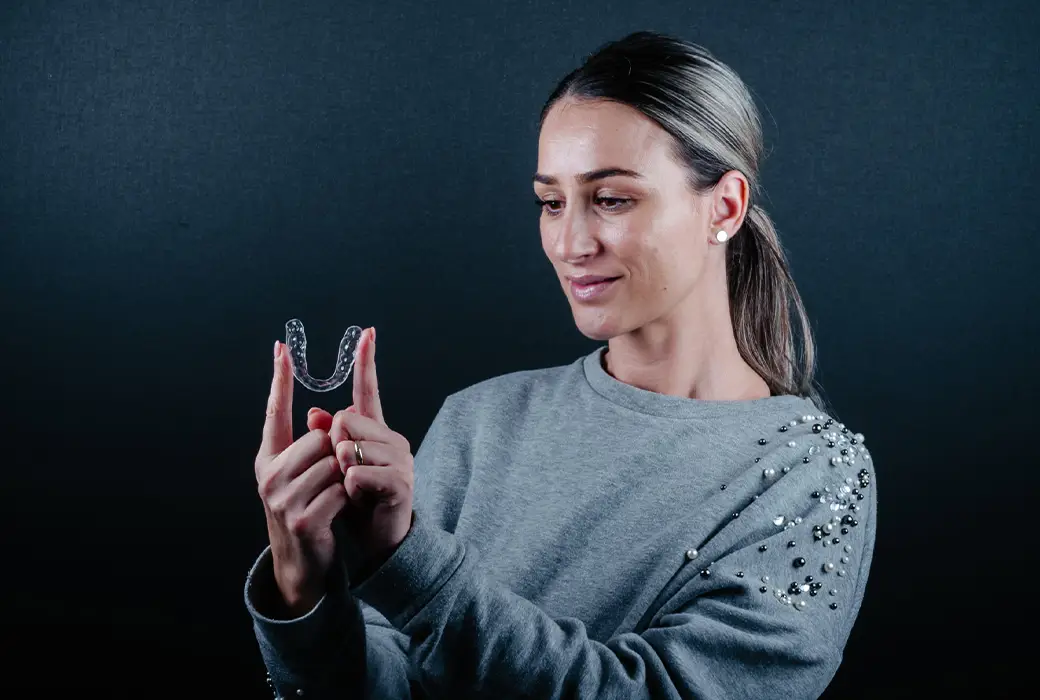
All about dental splints
Types and uses, benefits, and care
If the dentist has recommended wearing a dental splint, you are either dealing with an issue such as bruxism, have just completed orthodontic treatment or undergone an implant procedure, or need it for tooth protection. Besides these situations, it is also possible to wear a splint for teeth whitening, whose main benefit is aesthetic. In the following, you will learn everything about dental splints and the treatments in which they are necessary, their types and properties, as well as the proper way to clean and care for a dental splint.
What are dental splints?
Dental splints are defined as dental tools or devices made from materials such as calibrated plastic sheets or acrylic, which the dentist recommends for correcting dental issues (such as bruxism), diagnosing, or facilitating dental procedures. They are usually transparent but can also be made from colored materials in pediatric dentistry. Additionally, they are non-toxic and are crafted in dental laboratories based on a mold of the patient’s teeth to ensure a perfect fit. Dental splints are easy to wear, do not cause discomfort, and can be applied and removed by the patient in hygienic conditions.
Types of dental splints
Depending on their intended purpose, dental splints come in several types:
Dental splints for bruxism
Bruxism is a pathological habit of grinding the teeth, primarily occurring during sleep, which causes damage to the enamel (wear, cracks) as well as headaches and jaw pain. A dental splint is recommended to protect the teeth from these effects.
A dental splint for bruxism is made from a hard but flexible plastic and is applied to one dental arch. It resembles splints used in sports like boxing; however, it is important to customize it for each patient.
If you need such a splint, you should know that its creation requires two visits to the dental office: one for taking impressions of the arches and recording the occlusion, and another for fitting the splint on the teeth.
The dental splint for bruxism prevents the loss of hard dental tissue caused by the grinding of teeth due to bruxism. Additionally, the splint's role is to protect prosthetic restorations (dental crowns, veneers), prevent the occurrence of temporomandibular joint dysfunctions, and balance the position of the jaws before a restorative procedure.

The price of a splint for bruxism varies depending on the materials used. For more details about pricing, visit the DENT ESTET rates section. It should be worn for at least three months until the issue improves. However, a bruxism splint cannot be used for periods longer than two years or even less, as signs of wear such as cracks and perforations affect its effectiveness. Consequently, the splint should be periodically evaluated by the dentist and replaced as recommended.
Regarding the use of the bruxism splint, it should be worn in the evening, after brushing your teeth, right before going to bed. It is removed in the morning, cleaned, and stored in the specially designed container.
Orthodontic, retention, or repositioning splint
The retention splint is intended for patients who have undergone orthodontic treatment. It is generally recommended immediately after wearing braces and serves to prevent the teeth from returning to their initial position. The retention splint is much thinner than the bruxism splint, with a thickness of 1-1.5 mm, and is made from acrylic or a rigid resin. Typically, splints are transparent, but at the patient’s request, they can be made from colored sheets or with various patterns. It is often recommended to wear the splint full-time for the first two months after removing the braces, and then only at night. The orthodontist may gradually recommend limiting the splint wear to one or two nights a week.
In some cases, retention is permanent to prevent any recurrence. Retention splints help protect the jaw joint and dental arches and maintain the teeth in their new position. The price of a retention splint varies. For more details about pricing, visit the DENT ESTET rates section.
The repositioning splint is a special splint with an active role, unlike retention splints, which are passive. It is generally used to reposition one or two teeth that have experienced minor shifts due to orthodontic relapse. These splints are recommended to be worn for 15-20 hours a day, after which, once the teeth have been corrected, a permanent retention splint should be applied.

Dental splint for implants
A subtype of the retention splint is the implant splint. It is recommended for patients who have undergone an implant procedure, as well as for simpler dental work such as fillings (to protect them at night), and for relaxing facial muscles.
The cost of an implant splint varies across dental offices. For more details about pricing, visit the DENT ESTET rates section.
Dental splint for whitening
Teeth whitening treatments aim to improve the appearance of teeth affected by poor oral hygiene, habits such as smoking, or consumption of staining beverages (coffee, tea, red wine). Dentists recommend that these treatments be carried out professionally in the dental office. However, there are also whitening treatments available for home use, some of which involve wearing a whitening dental splint.
The whitening splint is made from a soft, transparent, and highly flexible plastic material. For optimal results, the whitening splint should be created in the dental office and dental laboratory based on the patient’s dental impressions, but it can also be purchased from pharmacies.
The whitening splint is used with a special gel. Depending on the concentration of the gel, the treatment duration may vary. Although the gel does not affect the tooth enamel or lead to loss of dental substance, it is recommended that such a treatment be done once a year or year and a half. Additionally, patients may experience sensitivity at the end of the treatment, but this usually resolves within a few days.
The price of a whitening dental splint can start from 100 RON in pharmacies. For more details about pricing, visit the DENT ESTET rates section.
Dental Protection Splint for Athletes
Protection splints designed for athletes are used in contact sports such as boxing, European and American football, basketball, hockey, baseball, as well as in gymnastics, mountain biking, or skateboarding. They protect the teeth and prevent oral injuries. In most cases, wearing such a splint is recommended for the upper jaw, but if the patient wears an orthodontic appliance or has a dental bridge on the lower part, a splint for the lower jaw is also used.
There are three types of dental protection splints:
- Custom-made;
- Universal;
- High-performance protection splints made from self-polymerizing acrylic.
Benefits of wearing a dental splint at night
Dental splints offer a range of benefits depending on their intended purpose. Those worn at night (such as splints for bruxism, retention, or implants) have several advantages:
- Prevent dental wear that can lead to tooth sensitivity;
- Reduce jaw tension, relax facial muscles, and prevent associated pain, including conditions like temporomandibular joint dysfunction (which occurs when the jaw joint is not properly aligned);
- Prevent headaches and tooth pain caused by bruxism (muscle fatigue, jaw pain, ear pain, or neck pain);
- Contribute to developing healthy rest habits by reducing discomfort and relaxing the muscles;
- Prevent snoring;
- Prevent serious dental issues and encourage good oral hygiene due to the recommendations for proper wear and maintenance.
Wearing, storing, cleaning, and maintaining a dental splint
For optimal results with your splint and to ensure its longevity, it is important to wear and care for it properly:
- Pay special attention to oral hygiene and thoroughly clean your teeth using both a toothbrush and toothpaste, as well as dental floss, before using the splint;
- Rinse both your mouth and the splint with mouthwash or cold water before and after applying it to prevent shape alterations due to heat;
- Use a toothbrush and toothpaste to clean the dental splint after each use;
- Regularly check the splint for any signs of damage;
- To ensure the splint's effectiveness, bring it with you to dental appointments; the dentist will check if it fits the teeth properly and if it is in good condition;
- Use the special case provided for storing the splint to protect it from heat and other factors like low humidity;
- Do not leave the splint within reach of pets, even when it is stored in the special case.
Keep in mind that dental splints have a limited lifespan. Once you notice signs of wear or reach the maximum wearing period (two to three years, depending on the type), the splint should be replaced. To ensure its longevity, follow these guidelines:
- Do not expose the splint to heat, as it may alter its shape, dry out, and crack;
- Always use the special storage container, even when traveling;
- Clean the splint after each use and allow it to air-dry for a few minutes.
Discuss with your dentist the need for wearing a splint and if you plan to purchase one for teeth whitening for home use. They will provide you with the best advice and recommendations for choosing the right splint, take accurate impressions for creating one in the dental laboratory, teach you how to wear and maintain it properly, and identify when it needs to be replaced.



